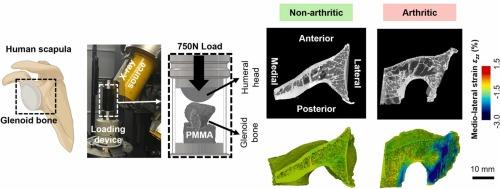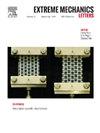Full-field strain distribution in non-arthritic and arthritic glenoid bones before and after implant placement measured by digital volume correlation method
IF 4.5
3区 工程技术
Q2 MATERIALS SCIENCE, MULTIDISCIPLINARY
引用次数: 0
Abstract
Loosening of the shoulder joint (glenohumeral joint) implant is a leading cause of failure in total shoulder replacement surgery, primarily due to mechanical strain concentration in the bone. This study combines in situ mechanical testing with micro-X-ray computed tomography (micro-CT) to apply physiologically realistic loads on non-arthritic and arthritic glenoid bones, the socket portion of the shoulder joint, before and after implant placement, and uses digital volume correlation (DVC) to analyze 3D deformation and strain distributions within the glenoid bones. The results show that degenerative changes in bone quality and structure associated with different arthritis subtypes redistribute strain under anterior and posterior eccentric loading. Strain distributions were compared across arthritis subtypes before and after implant placement, with results indicating that implant placement often helps alleviate strain concentrations. Additionally, the percentage of bone volume experiencing strain beyond the physiological strain range typically encountered during daily activities was assessed. While the proportion of bone exceeding this strain threshold was comparable between non-arthritic and arthritic glenoid bones post-implantation, strain magnitude was notably higher in arthritic specimens, potentially increasing the risk of implant loosening. These findings provide insights for optimizing preoperative planning and implant design tailored to patient-specific bone characteristics, potentially enhancing implant longevity and reducing the risk of post-surgical loosening in patients with glenohumeral arthritis.

用数字体积相关法测量假体置入前后非关节炎和关节炎关节盂骨的全场应变分布
肩关节(盂肱关节)假体松动是全肩关节置换术失败的主要原因,主要是由于骨中的机械应变集中。本研究将原位力学测试与微x射线计算机断层扫描(micro-CT)相结合,在植入假体之前和之后对无关节炎和关节炎的肩关节窝部分施加生理上真实的载荷,并使用数字体积相关(DVC)分析肩关节内的三维变形和应变分布。结果表明,不同关节炎亚型的骨质量和结构的退行性改变在前后偏心负荷下重新分配了应变。我们比较了植入前后不同关节炎亚型的应变分布,结果表明植入通常有助于缓解应变浓度。此外,还评估了在日常活动中通常遇到的超出生理应变范围的骨体积的百分比。虽然超过该应变阈值的骨比例在植入后非关节炎和关节炎关节盂骨之间是相当的,但关节炎标本的应变值明显更高,潜在地增加了植入物松动的风险。这些发现为优化术前计划和针对患者特定骨特征量身定制的植入物设计提供了见解,有可能提高植入物的使用寿命,降低肩关节关节炎患者术后松动的风险。
本文章由计算机程序翻译,如有差异,请以英文原文为准。
求助全文
约1分钟内获得全文
求助全文
来源期刊

Extreme Mechanics Letters
Engineering-Mechanics of Materials
CiteScore
9.20
自引率
4.30%
发文量
179
审稿时长
45 days
期刊介绍:
Extreme Mechanics Letters (EML) enables rapid communication of research that highlights the role of mechanics in multi-disciplinary areas across materials science, physics, chemistry, biology, medicine and engineering. Emphasis is on the impact, depth and originality of new concepts, methods and observations at the forefront of applied sciences.
 求助内容:
求助内容: 应助结果提醒方式:
应助结果提醒方式:


